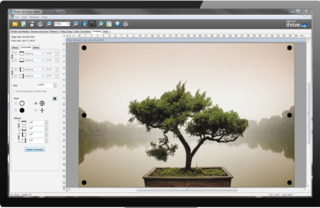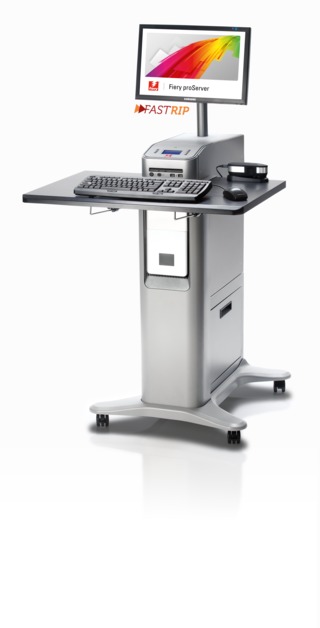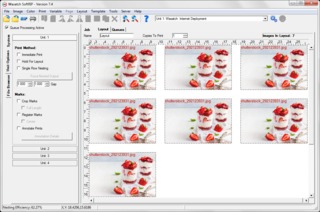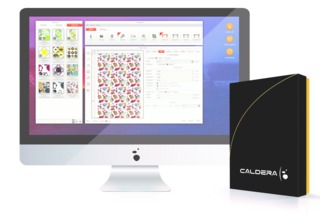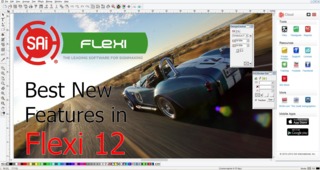The Evolving RIP
RIPs are taking on more of the task in creating truly efficient workflows.
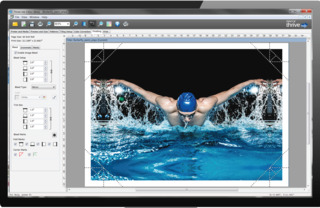
Not too long ago, a RIP was little more than what its name – raster image processor – implied. It was essentially a processor. But as the saying goes, that was then and this is now.
These days, RIPs have been transformed from basic translators into comprehensive control centers that govern beginning-to-end production workflow, overseeing such widely varied functions as page layout, color management, preflighting, automation, and much more.
Whereas once the wide-format RIP might have enabled such basic functions as tiling, today, it is to a much greater extent a workflow and communication tool. RIP manufacturers have found themselves having to continually up their games to ensure their products keep pace with the evolution of other facets of the wide-format print enterprise.
These days, print providers are increasingly demanding faster workflows, the ability to automate more processes, and the opportunity to take on more and more innovative print projects in an effort to differentiate themselves from competitors. As their reach grows longer, RIPs will be asked to shoulder more of the task in making workflows more efficient.
Automation, integration, and new opportunities
When it comes to the trends in the RIP marketplace and in RIP technology, few are more important than the desire of print providers to increase the speed of the production process. So says Bryan Manwaring, director of product marketing for Onyx Graphics. “The best solutions today are driving print shops to greater profits with print production tools customers can rely on,” he says.
“We have found what customers are asking for is the ability to get through production quicker. This means RIP providers need to really understand the products shops are selling and provide tools that make them easy to produce. Anywhere in the process that can be sped up or automated is going to drop immediately to the bottom line for businesses.”
At SA International (SAi), product director Dean Derhak and colleagues have been saying for years that value-added applications and production data are important to print providers. “And now we see our competition following us in that direction,” Derhak reports. ”For example, business owners use our Flexi RIP's mobile apps to see their production trends and create quick job quotes while on the go.”
SAi is also witnessing demand for subscription-based RIP software, Derhak says. This trend provides the astute print provider top-tier RIP software and phone support without a huge upfront cost or service contract. “Demand is also increasing,” he notes.
“In just three years since we introduced the industry's first subscription based RIP software, our subscribers have reached more than 7,500.”
The shop desire for greater automation is being experienced elsewhere as well.
“We see automation and integration as being the primary trends,” says Kerry Moloney, product marketing manager for Fiery wide-format products with EFI. “People do calculate media and ink usage today, but do it more manually. We see people wanting to automate that process. If you have a system that can place a print job in a folder and have it come out the other side in a fully automated way, that's very important to print providers. So automation is something we see more and more interest in every day.”
Intriguingly, she adds, automation is much more advanced in Europe than in North America. These trends often have much to do with the level of profit in jobs and the degree of competition in the market.
Automation ensures a job goes through the system automatically, and to accomplish that there must be information attached to the job. That information might include what paper the job is being printed upon and how much ink is being expended, Moloney says.
“Integration is really about the job flowing through the system, and information about the attributes of that job going through with it,” she adds. “In web-to-print, if a job is submitted online, the person submitting the job chooses the paper, the copies and the finishing options. What's happening behind the scenes is integration. [The next] level of that is do we want to take that data about how much ink and how much paper was used and do we want to report back on that, or analyze that data?”
“Integration is about using that data in other places to give us business analytics – trends, usage, and operator data. This is the only place this data resides. If a RIP is running multiple devices, people are looking at the RIPs as repositories of business information data, in addition to [garner information about] how the job should be run.”
Greater automation is also seen as a trend by Ashley Wanlass, senior marketing specialist with Wasatch Computer Technology, Achieving superior color and consistent output will always be a priority, says Wanlass, “But currently the hottest trend is automation. Today’s marketplace demands increased customization and quick order turnaround, which can be eased through automation through the RIP,” she says.
“RIP software now provides efficient methods to automatically process and print jobs. Barcode-driven workflows, advanced hot folder features, email status reporting, and customer HTML interfaces help give control and transparency throughout the production process.”
In addition to the need for greater speed, automation and information, another trend impacting the industry centers on new opportunities to print products once beyond the reach of PSPs, says Arnaud Fabre, product manager with Caldera.
Digital inkjet printing is now opening up new possibilities focused on textiles and carton-based media – not only for soft signage and point-of-sale, but also fashion, home decoration and corrugated packaging. Caldera is one RIP maker responding to these developments through such products as Textile Pro, a RIP dedicated to textile printing, he says.
Textile Pro has an intuitive interface that gives PSPs the assurance designs and colors will be matched during production. It enables creation of patterns, variations and repeats while eliminating error and waste. The resulting workflow is stable, accurate and prepared for everything from full-bleed decoration, functional textiles, prototypes or high-speed runs, due to the incorporation of swatch and pattern tools, standards-ready color management and advanced machine control. Plus, with its new Caldera V11 core architecture, Textile Pro is compatible with all major textile printers, making it a fast choice for new textile applications.
Finding value-add
There are a number of variables shops may weigh when considering the purchase of a RIP. According to Manwaring, it's critical that print providers consider their entire production and what is needed across the entire range of their equipment. “In today's market, you should expect the ability to run your entire site with a single solution,” he says. “Many shops today have a variety of RIP software packages in the shop, depending on the equipment they have purchased.
“It is easy to underestimate the cost of having your production employees learn and use multiple products. With a single solution and the right production tools, problems of matching the color output from one device to another can virtually disappear.”
Wanlass also believes a holistic view must be taken before buying. RIP software is about more than just achieving outstanding color, she notes. Because it is, each shop must look for a RIP fitting its production and order processing workflow. “In today’s market, RIP software needs to have automation features that can easily be customized, are scalable and will work with an entire collection of printers,” Wanlass says.
“Shops with large operations often have their production set up in such a way that no one actually touches the RIP software. All of the production is done via the network where jobs are RIPed and printed through hot folders or using a custom HTML page.”
Such a workflow operation trims errors and boosts output/productivity, she says.
In Moloney's view, purchasers should focus on RIPs at industry standards. “A graphic-arts standards focus will give you better, more consistent results that will allow you to produce more consistent and accurate results, resulting in keeping customers happy,” she says. “What that's translating to is more consistent, higher-quality predictable results. We are seeing shops being more focused on printing industry standards, regardless of the size of the shop or the customer. That's because that helps ensure customers always get what they expect, with no surprises.”
Prepress tools integrated into the RIP software make little real difference now that every single RIP provides more or less the same signage functionalities, Fabre says. “As has always been the case in the past, Caldera innovations drive the RIP market, and printers should consider the ecosystem that Caldera offers to help them grow and become efficient,” he adds. “Caldera proposes a production infrastructure, instead of just a RIP; it offers coherence, flexibility, and fault tolerance with its client-server architecture based on Mac OS and Linux systems, and integration with all the other company departments with Nexio or StreamLive products.”
For Derhak, the key is RIP software that does more than just RIP jobs. The software should have value-added features that help PSPs run their businesses. As an example, Derhak says, SAi's RIP software includes a complete web-based artwork approval tool enabling PSPs to garner customer approvals more expeditiously.
PSPs should seek RIP software featuring specific tools to streamline the production of their top print applications. If a PSP produces a great number of banners, a RIP with a banner finishing tool can dramatically cut preparation and finishing times. “The biggest mistake PSPs make is sticking with the RIP software that came with their printer,” Derhak asserts. “These bundled RIPs can get the job done, but typically do not include the value-added features that increase production efficiency. In today's world, that means not meeting customer deadlines while the shop down the street can because they use a top-of-the-line RIP solution.”
Pushing equipment to the limits
There is a great deal of imagination and creativity being incorporated into today's print production, Moloney observes. Print service providers are pushing the envelope of printing creativity to satisfy today's evolving market demands. “We see a trend to produce more and more creative styles of prints. Whatever that might be, from large to small, [it's happening] because the printing technologies are capable of doing it. PSPs are pushing their equipment to the limits of what it can do to meet the market needs. Variable data is still growing, soft signage is still growing and inevitably there is more digital production in the industrial print industry, which is definitely a growth marketplace. We print on textiles, on ceramics at EFI.”
As a result of the growth of variable data, personalization, customization, and soft signage, print providers are purchasing more diverse equipment, and not specializing as much as they once did. What's key, Moloney says, is “having the equipment that does the broad variety of work the market needs,” as well as the ability to challenge their equipment, pushing the boundaries of the conventional to attempt new and different kinds of printing.
“We try to increase performance with every release, and we are keeping up on printer speed, to allow people to maximize their investment,” Moloney says.
For his part, Manwaring reports over the past two years, Onyx Graphics has invested significantly in making production much faster. In its last two major releases, the company has achieved RIP times 20 times faster than ever seen before. “What customers have told us is this translates directly into profit,” he says. “By even producing one additional job a day, that can have a huge impact on a print shop's profit margin. Beyond pure RIP speed, there are automation technologies that can prepare an entire print application without any manual setup needed. This means that work is easily and accurately reproducible without mistakes.”
SAi is focusing on adding value-added features to its RIP software that greatly assist print businesses' growth. The company operates SIGN.COM, which lets the consumer-buying public customize signs online, Derhak says.
“We route all SIGN.COM orders to Flexi RIP software PSPs for local fulfillment. This is possible because Flexi RIP software includes a web window that connects PSPs to the SIGN.COM network as well as other value-added tools. PSPs want more business insights that help them understand their production trends and costs, which is why we have invested heavily into data analytics and reporting. We recently added a production dashboard to the Flexi RIP companion mobile app and will be introducing other valuable reporting tools.”
The company has focused its Flexi RIP software on improving productivity throughout the production workflow. From helping get customer artwork approved quicker to one-click contour cut paths and faster weeding, Flexi RIP does much more than just RIP and print jobs.
“Most PSPs tell us their biggest production bottlenecks are not at the RIP step of their workflow,” Derhak says. “So increasing RIP speed or requiring a 64-bit PC are not the best ways RIP vendors can improve print business productivity . . . We added a Smart Nesting Tool in the latest Flexi RIP software that nests jobs according to their shapes. That can reduce media waste up to 60 percent on print-and-cut jobs.”
The marketplace is continually evolving, making it more important than ever to listen to RIP software users’ needs, Wanlass says. For instance, shops are increasingly processing smaller orders requiring quick turnarounds as opposed to tackling larger but fewer orders.
“The best way to streamline a greater amount of orders is to automate as much of the print production as possible,” she reports. “For example, a barcode-driven workflow, like Wasatch’s Barcode Pull, pulls a job into the production workflow, automatically RIPping and printing a job, by simply scanning a barcode. New RIP technologies focused on automation can efficiently streamline orders, eliminate production errors and increase productivity. Implementing this technology has [been] shown to save shops time and money.”

